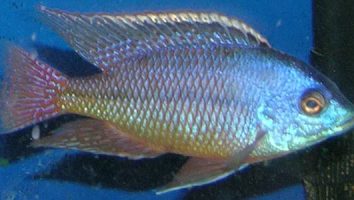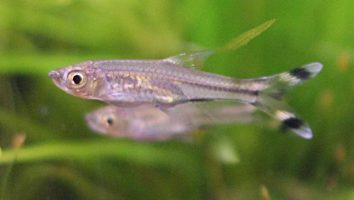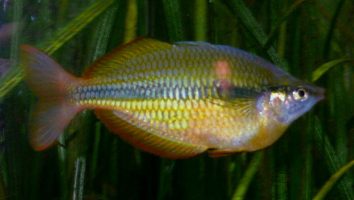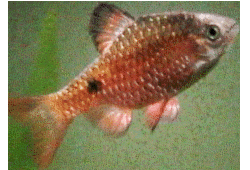Polka dot syno is a beautiful freshwater fish that is easy to care for. They are a peaceful fish that gets along well with other fish. Polka dot syno are a great addition to any freshwater aquarium.
This guide will teach you everything you need to know about Polka dot syno care. You’ll learn about their diet, size, lifespan, and more!
Table of contents
Species overview
Polka dot syno (scientific name: Synodontis nigriventris) is a freshwater fish that’s native to the Congo River basin in Africa.
Although they are found in other areas, the majority of these fish live in and around the Congo River. This is a large river that runs through the middle of the continent and has a lot of different tributaries.
The polka dot syno prefers slow-moving water with a lot of vegetation. This is something that’s common to many species of syno, as they are generally found in rivers and streams.
This fish is a bottom-dweller and spends most of its time hiding among the plants and roots. They are nocturnal creatures and come out to feed at night.
The polka dot syno is a popular choice for aquariums because of its unique coloration. These fish are black with white spots all over their bodies.
Appearance

Polka dot syno catfish are one of the more unique and interesting looking freshwater fish out there. As you can probably guess from their name, their bodies are covered in black spots on a white background.
These spots are not only on their body but their fins as well. In fact, the spots on their fins are a bit larger than the spots on their body.
These fish have a long and slender body shape that is slightly flattened from top to bottom. They have a large head with small eyes. Their mouths extend past their eyes and are filled with small, sharp teeth.
The dorsal fin on these fish is tall and thin. It starts about halfway back on the body and extends all the way to the tail. The anal fin is a bit shorter and thinner than the dorsal fin.
The caudal fin is forked and fairly large. The pectoral fins are small and thin. The ventral fins are also small and thin and are located just behind the pectoral fins.
Lifespan
The lifespan of the Polka Dot Syno can range from 5 to 10 years. The average lifespan is usually closer to 5 years, but with proper care, these fish can live much longer.
As with any other animal, the lifespan of the Polka Dot Syno can be affected by a number of different factors. Things like diet, water quality, and stress levels can all impact how long these fish live.
Size
A full-grown Polka Dot Syno catfish can reach a size of up to 8 inches. However, they are typically a bit smaller in the home aquarium, only reaching about 6 inches.
Tank
Tank Size
The Polka dot syno catfish should be kept in at least a 30 gallon tank, with the bigger the tank the better. If you plan on keeping more than one Polka dot catfish, you should add an additional 10 gallons for each fish.
Water Parameters
The Polka Dot Syno is a freshwater fish that requires specific water parameters in order to stay healthy.
The ideal water parameters for this fish are as follows:
- Water Temperature: 72-82 degrees Fahrenheit
- pH Levels: 6.8-7.6
- Water Hardness: 2-12 dGH
- Alkalinity Levels: 4-8 dKH
If you are able to maintain these water parameters, your Polka Dot Syno will be a happy and healthy fish!
What To Put In Their Tank
As with any fish, the first step in setting up their tank is to choose the right size. Polka Dot Syno cats are a fairly small species, so a 30-gallon tank is more than enough for a single fish. If you want to keep more than one, you’ll need to increase the size of the tank accordingly.
When it comes to the substrate, these fish don’t have any specific requirements. A simple gravel substrate will work just fine.
As for plants, you can include whatever you want. Just be aware that these fish are known to nibble on vegetation, so choose something that can handle a little bit of damage (hornwort or water wisteria are good choices).
When it comes to decor, the sky’s the limit. These fish are relatively uninterested in their surroundings, so you can include whatever you want. Rocks, driftwood, and caves are all fine.
Just be sure to avoid anything too small or sharp. These fish are known to dig around in the substrate, and you don’t want them to hurt themselves.
Common Diseases
Polka dot syno are a pretty hearty fish, but that doesn’t mean they don’t get sick from time to time. The most common diseases that these fish experience are the usual freshwater culprits.
Ich is the most common, but various other infections and parasites can strike too. Be on the lookout for anything out of the ordinary so you can act fast.
White spots, scars, cuts, or a change in behavior are all causes for concern. Even a disease that isn’t very severe can progress into something serious if left untreated.
When you notice something it’s important to act fast. Consult your vet and begin treatment immediately. The sooner you act, the higher the chance is that your fish will recover.
Of course, the best way to keep the risk of disease low is by simply keeping the tank in great shape. Not providing clean, high-quality water conditions will significantly increase the chance of your Polka dot syno getting sick.
Behavior & Temperament
Polka dot syno are relatively peaceful fish. They are not known to be aggressive towards other fish and will typically leave them alone. The only time they may become aggressive is if they feel threatened or are not getting enough food.
These fish are bottom-dwellers and prefer to stay near the bottom of the tank. They are not known to swim in the middle or top of the water column very often.
Polka dot syno are nocturnal fish, so they are most active at night. During the day, they will usually hide in caves or other hiding places.
Overall, these fish are relatively easy to care for and make a good addition to most aquariums.
Tank Mates
Polka dot syno catfish are a bit pickier when it comes to finding the right tank mates. These fish come from fast-moving waters in South America.
As a result, they’re used to a lot of water movement. This is something to keep in mind when choosing their tank mates.
The good news is that there are plenty of other peaceful fish that come from the same general region. Here are some compatible species to consider:
- Cardinal Tetra
- Rummy Nose Tetra
- Black Widow Tetra
- Neon Tetra
- Bloodfin Tetra
- Serpae Tetra
- Whitefin Shark
- Silver Dollar Fish
Breeding
Polka dot syntos are livebearers, so breeding them is as simple as keeping a male and female together in the same tank. The female will give birth to anywhere from 5 to 20 fry at a time, and she can have multiple births per year.
To increase the chances of a successful birth, set up a breeding tank in advance. It should be at least 20 gallons and filled with soft, alkaline water. Live plants will provide hiding places for the fry, and floating plants will help to keep the water quality high.
Once the fry are born, they will be able to fend for themselves. The female will not eat them, but the male might. It’s best to remove the male from the tank after the fry are born.
As they grow, you can feed the fry live foods like brine shrimp and bloodworms. You can also give them crushed-up flake food.
Conclusion
Polka dot syno care is actually quite easy once you understand their needs.
These fish are very peaceful and make a great addition to any community tank. They’re also very easy to care for, which is always a bonus.
Overall, we think the Polka dot syno is a great fish for beginner aquarists or those who want a low-maintenance pet.












